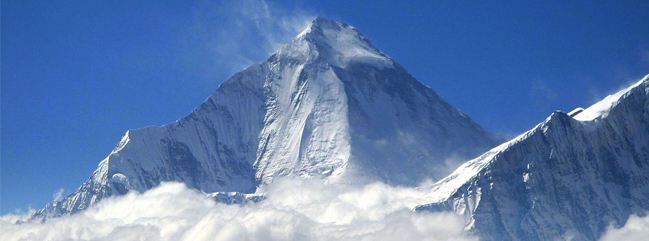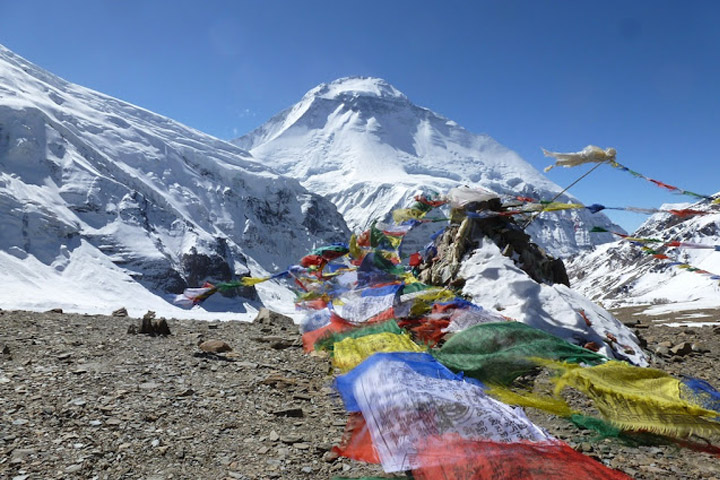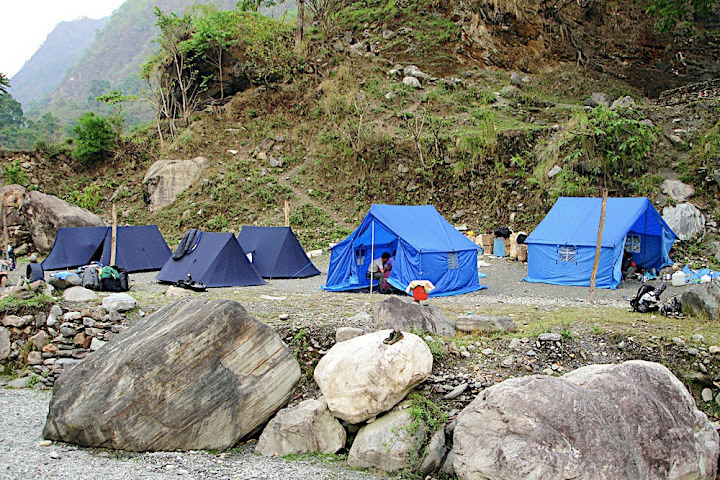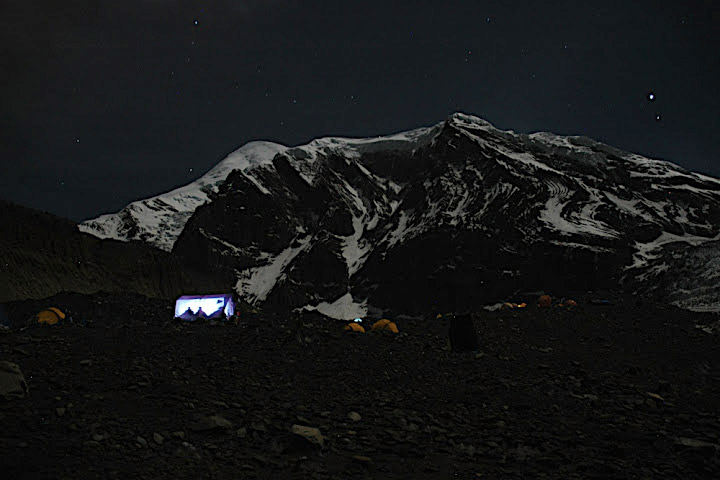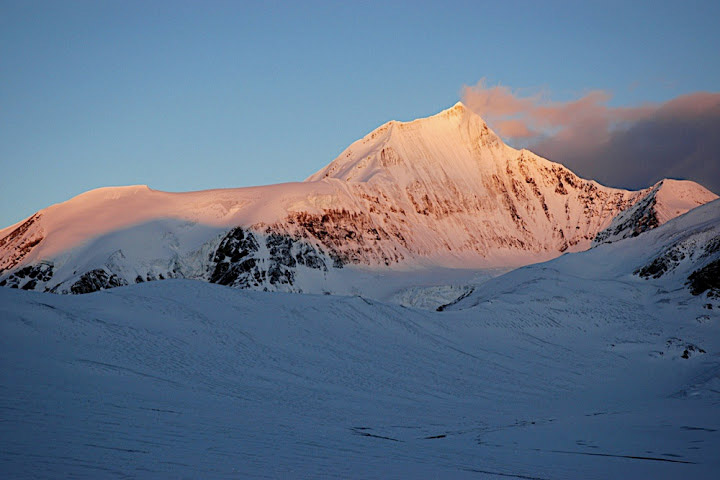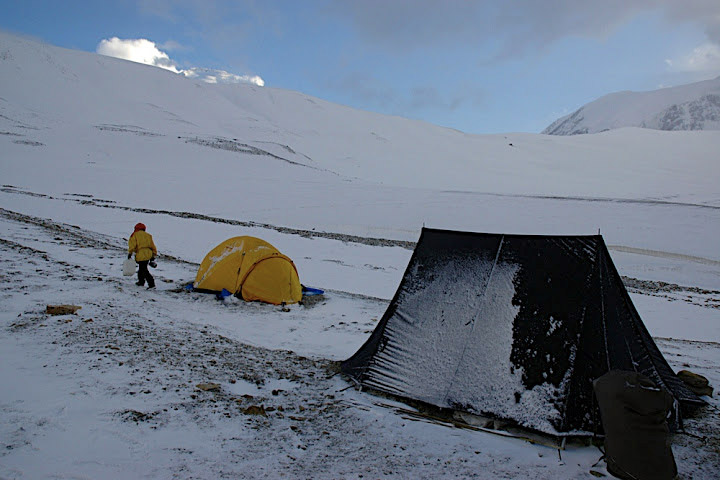Dhaulagiri 8167 meters 7th highest mountain in the world means “white mountain” though many mountains over the world have names, which translate to White Mountain; this is without doubt the most astonishing one. This is a strenuous trek, through high alpine pastures, higher passes and serene and uninhabited valleys. Everyone is familiar with the name Dhaulagiri which is in the western part of Nepal, probably the best spot for remote and adventurous trekking in Nepal. The simple reason behind it is that it consists of more than fifteen 7000-meter magnificent peaks with land of dramatic contrast.
Dhaulagiri trekking routes starts after an 8 hour scenic drive from Kathmandi to Beni, from Beni you head in a north-westerly direction through the villages of Babichour, Dorbang and Darapani to Muri, from where you head north still keeping to the banks of the Myagdi Khola. Muri is the last major settlement along this trail and is inhabited by people of the Magar tribe, of Mongoloid stock and descended from the early settlers of the Nepalese middle hills. From Muri, you head north along the Myagdi Khola through the villages of Baghara, Dobang and Chartare to Pakoban. Beyond Pakoban there are no permanent settlements. Still heading north you skirt the Chhanbardan Glacier, keeping on its left side, to reach the Dhaulagiri Base Camp from where magnificent mountain vistas are available. Head north-east from the Base Camp and climb the steep incline to the French Pass (5,360 meters), between Tukche Peak (6,920 meters) and Sita Chuchura (6,611meters). Heading east you descend a little and pass through a portion of the Hidden Valley and climb to Thapa Pass (5,250 meters), between Tukche Peak and Thapa Peak (6,012 meters) from where you begin your descent, heading south-east to Alubari. From Alubari, the trail further descends to the village of Marpha on the banks of the Kali Gandaki River, and then heads north to Jomsom from where you fly back to Pokhara.
For those who have got enough time there is an option of continuing to trek down to Kalopani, Tatopani, Ghorepani then into Pokhara.
Day 01- Arrival in Kathmandu airport (1345meters).
There you will be met by our Airport Representative and transferred to hotel by private tourist vehicle. Overnight at hotel.
Day 02- Pre-trip Meeting and Sightseeing around Kathmandu valley.
In the morning after breakfast at 9 AM, we host a Pre-Trip meeting at your hotel in Kathmandu and introduced your trek Leader/Guide mean time and it will provide an opportunity for individuals to ask questions about the your trek and to introduce you to other participants. This includes a final briefing and preparations for the trip.
PLEASE ADVISE US IF YOU WILL BE ARRIVING LATE AND ARE THEREFORE UNABLE TO ATTEND THE PRE-TRIP MEETING.
In THE PRE-TRIP MEETING All passengers MUST bring:
1. Passport.
2. Four copies of Passport size photos each.
3. Travel Insurance Policy.
4. A writing pen
5. Notepad.
After the Pre-Trip meeting and breakfast your sightseeing trip will start at 9.45 AM in the morning. We provide a private vehicle and professional tour guide. We visit Bodhnath Stupa, one of the biggest Buddhist shrines in the world, where we observe Buddhist monks in prayer in the monasteries surrounding the stupa. After Bodhnath Stupa we visit Pashupatinath, the most famous Hindu temple in the country, located on the banks of the holy Bagmati River. Here we see Hindu holy men (sadhus) meditating, pilgrims bathing and occasionally funeral pyres burning on the ghats. We also visit Bhaktapur Durbar Square, which is a collection of pagoda and shikhara – style temples grouped around a fifty-five-window palace of brick and wood. The attraction of the Bhaktapur Durbar Square is The Lion gate, The Golden gate, The Palace of fifty five windows, Art Galleries, The Statue of King Bhupatindra Malla.
The rest of our time in Kathmandu is free for further exploration and some last-minute shopping in Thamel area near by your hotel. Later, we are supplied with our Trek Pack and departure information for tomorrow. Overnight at hotel.
Day 03- Drive to Beni (850meters) by bus 8 hours.
After your breakfast, you drive to Beni. The drive should take 8 hours and you’ll find most of the scenery very enjoyable. Beni is the district headquarters and has a police check post where your trekking permits will be examined. Beni is at the confluence of the Myagdi Khola and the Kali Gandaki. Overnight at tented camp.
Day 04- Trek to Babiachor (950 meters) 5 hours.
Leaving Beni and Kali Gandaki the trek heads west along the north bank of the Myagdi Khola through the village of Beni Mangalghat to Singa and Tatopani (hot springs). Crossing the bridge beyond the village to the south bank of the river, the trail makes a little half loop before crossing another bridge, near the village of Simalchour, back to the north bank from where it continues to the village of Babichor. Overnight at tented camp.
Day 05- Trek to Dharapani (1,400meters) 6 hours.
The valley widens and terraced hills develop on both sides of the river. The trail is fairly level and you pass the village of Shahashradhara, cross the Duk Khola and walk through fields arriving at Ratorunga. From here the valley narrows again and terraces disappear on either side of the river. Continue to the village of Dharapani. Overnight at tented camp.
Day 06- Trek to Muri (1,850meters) 5 hours.
After crossing the river to its West Bank as you leave Phedi the trail starts climbing in earnest and there will be many switch-backs until you arrive at the ridge and the angle of ascent eases. Again the trail climbs steeply to the villages of Muri. Continue your trek to Sibang and Mattim. From here you continue up an incline to the snout of the ridge, descend to the Gatti Khola and reach Phalai Gaon (1810meters). Cross the Dhara Khola to once again emerge on the west bank of the Myagdi Khola and then climb a ridge to the large Magar village of Muri. Overnight at tented camp.
Day 07- Trek to Boghara (2080meters) 6 hours.
Descend a little, cross a stream and continue through terraced fields before climbing a ridge to reach the pass from where you can see Mt. Ghustung South (6465 meters). Descend to the Myagdi Khola and trek along its West Bank to the village of Naura from where you will climb a little before traversing a grassy hill and climbing a steep slope with switch-backs, then descend through a forest and terraced fields to Boghara (2080 meters). Overnight at tented camp.
Day 08- Trek to Dobang (2,520meters) 5 hours.
The trail first descends through terraced fields to a small ridge, then through a forest to Jyardan which is the most remote permanent settlement in this part. After the settlement a high winding path crosses a rocky area which then descends before climbing again to Lipshe where there is on single hut. The trail continues through a forest to Lapche Kharka and then climbs to the level area at Dobang. Overnight at tented camp.
Day 09- Trek to Choriban Khola (3,110meters) 5 hours.
After crossing a wooden bridge out of Dobang the trail ascends a forested area. Soon the west face of Dhaulagiri I (8167 meters) becomes visible through breaks in the trees. Descend to the Myagdi Khola and cross via a wooden bridge to the east bank continue to Chartare. Passing through forests again, you cut across a rocky area and cross a stream to Choriban Khola. Overnight at tented camp.
Day 10- Trek to Italian Base Camp (3,660meters) 7 hours.
Follow a trail to the terminal moraine of the Chhonbarban Glacier and enter the glacier from the right. Tukche Peak (6837 meters) becomes visible straight on; at the far end while the impressive north flank of Dhaulagiri I (8167 meters) dominates the skyline to your right. After a short while you will reach Italian Base Camp (3660 meters), which is also the site of your camp for the night. To the west are the peaks of Dhaulagiri II (7751meters), Dhaulagiri III (7715 meters) and Dhaulagiri V (7618 meters). Overnight at tented camp.
Day 11- Acclimatization and rest day.
We will spend a day here in order to acclimatize and adjust to the thinning of the air. It is recommended that your body acclimatizes to the high altitude and be “tuned” for the even higher altitudes to come. Overnight at tented camp.
Day 12- Trek to Glacier Camp (4210meters) 6 hours.
Set up early in the morning when the weather is expected to be clear. This Trail is prone to stone fall, which passes through a narrow gorge. Today we stay overnight near at glacier. Overnight at tented camp.
Day 13- Trek to Dhaulagiri Base Camp (4740meters) 7 hours.
This is one of our adventurous days to Dhaulagiri base camp. From here you can look up at the impressive north face of Dhaulagiri I (8167 meters) dominating the skyline to your right. To the west are peaks of Dhaulagiri II (7751meters), Dhaulagiri III (7715 meters) and Dhaulagiri V (7618 meters). In front of you is the impressive icefall that descends from the north east col. Overnight at tented camp.
Day 14- Another acclimatization and Rest Day.
Another rest day, but very important for the acclimatization. Views from this place are superb and there is plenty to explore. Overnight at tented camp.
Day 15- Cross French Pass (5360 meters) then trek to Hidden Valley (5200meters) 6 hours.
After the glacier you climb two terraced hills, the first of which runs along the glacier, then cutts across the mountain flank and the moraine you enter a gentle incline on the left from an ablation valley. Climb this gentle slope to the French Pass (5360 meters). A great vista opens up from the French Pass and you will be able to see Mukut Himal (6328 meters), Tashi Kang (6386 meters) and Sita Chuchura (6611 meters), all of which surround the Hidden Valley. To the south is Tukche Peak (6920 meters) and beyond is the massive peak of Dhaulagiri I. From French Pass you continue along the right edge of the Hidden valley losing a little altitude to Thapa Pass (5250meters) between Tukche Peak and Thapa Peak (6,012 meters). Descending from Thapa Pass you will make it to camp at 5200 meters. Overnight at tented camp.
Day 16- Cross Dhampus Pass (5200 meters), and trek toYak Kharka (3,680meters) 6 hours.
Descend from the hidden valley to the Dhampus Pass and continue to Yak Kharka. There is a perfect camp site to enjoy the surroundings. Overnight at tented camp.
Day 17- Trek to Jomsom (2,710meters) 5 hours.
Descend to the village of Marpha, on the west bank of the Kali Gandaki River. Marpha is home to many apple orchids as well as all the various food products made from fruit. Apple Brandy is a local specialty that you may be lucky enough to taste en route. Continue north, up the river valley to the town of Jomsom. Overnight at tented camp.
Day 18- Thirty five minutes morning fly to Pokhara (900 meters) and sightseeing same day.
Today 35 minutes morning flight takes us to Pokhara from Jomsom. Once we arrived at Pokhara airport, we then drive to hotel. In the afternoon we will have a sightseeing tour around Pokhara valley, which covers Fewa Lake, Devi’s water fall, Museum, Tibetan refugee settlement and Gupteshower cave etc. Overnight at hotel.
Day 19- Leisure day in Pokhara.
It’s also spare day in case of bad weather in Jomsom. Overnight at hotel.
Day 20- Drive to Kathmandu by bus 7 hours.
Overnight back at the hotel in Kathmandu by bus. If you are interested in continuing onto Chitwan Jungle Safari, River Rafting Adventure, Kathmandu Shopping Tour or Scenic Everest Flight. Overnight at hotel.
Day 21- Transfer to international airport for your final departure.
The trip ends, our Airport Representative will drop you to the Kathmandu international airport for your final flight departure from Nepal.
NOTE: The above information is a guide and standard template of what we provide. The trek can be customized at your request to accommodate your specific requirements.
Note : On adventure trips of this type, weather, local politics, transport or a multitude of other factors beyond our control can result in a change of itinerary. It is, however, very unlikely that the itinerary would be substantially altered; if alterations are necessary the leader will decide what is the best alternative, taking into consideration the best interests of the whole group. Where a change does occur, we do everything we can to minimize its effect, but we cannot be responsible for the results of changes or delays.
Q.What type of shape do I need to be in, is this trip for me?
A. Trekking is suitable for average people who are moderately fit, thus no previous experience is required. Some physical fitness programs such as running, swimming, hiking is recommended before you embark on your journey. Persons suffering from a pre-existing medical condition or disease must seek medical advice before considering the trek. Whilst on the trek, it is common to experience some discomfort before being fully acclimatized.
To prepare for a strenuous trek you should begin training at least two to three months before your departure. As a guideline, an hour of aerobic exercise three to four times per week would be considered a minimum requirement. The best preparation is bushwalking involving relatively steep ascents and descents. If you can manage a couple of valley floor to ridgeline ascents per comfortable and able to enjoy the trek to the fullest. They are physically strong, sharp-witted and have an incredibly positive attitude towards a life that we would consider extremely tough. There is something about a trek in the Himalaya that draws you back time and time again. For keen walkers it is a paradise and even avowed non-walkers find that one foot just seems to follow the other, drawn by the appeal of what lies beyond.
Q. Will somebody come to pick me up at the Airport upon my arrival?
A. Yes, our Airport Representative will be there to greet you outside of Terminal Hall, he/she will be displaying an Kiwi Adventures Treks & Expedition sign board. Upon arrival, you will be transferred to your hotel.
Q. What sort of accommodation can I expect in Kathmandu and in trekking?
A. 11 night’s Trekking Guesthouse, 4 nights three/four star hotels in Kathmandu.
We use standard rooms from three/four star hotels in Kathmandu with breakfast included. Along the trekking routes teahouses/Lodges generally provide basic clean facilities with a mattress and a quilt or blanket. We can also offer you sleeping bags if needed (which need to return after the trip) but it is a good idea to always have your own sleeping equipment. We usually provide single and double rooms as well as the occasional dormitory. The dining room is downstairs around a fire. All food will be cooked to order in the little kitchen. You should not enter the kitchen unless asked to do so.
Q. What sort of food can I expect in trekking?
A. In trekking most teahouses (lodges) cook a delicious range of mostly vegetarian fare. Pasta, tuna bakes, noodles, potatoes, eggs, dhal bhat, bread, soups, fresh vegetables (variety depends on the season) and even some desserts like apple pies, pancakes, and some interesting attempts at custard. You will find a lot of garlic on the menu because it assists with acclimatization – eat some every day. In many larger villages you may find some meat on the menu. You can always get hot chocolate, tea, and hot lemon drinks, as well as soft drinks, and treats like chocolate and crisps.
Each day dinner and breakfast are used to take in the same lodge you spend the night. Lunch will be taken on the way to destination.
Q. What sort of transportation you use?
A. Kiwi Adventures Treks & Expedition is all about providing you with local insights as well as adventure, with that in mind, where we think you will get more out of your holiday by using different means of transport that is what we do. Using a variety of private transport is an integral part of our Himalaya tours and enhances the experience!
We use private tourist vehicles for sightseeing, city tours and pickups. Depending on the group size we use cars, minibus, van or land cruiser. These small light vehicles are more manoeuvrable and flexible enabling us to take you through the Narrow roads of Nepal. All the vehicles are usually air-conditioned unless we are travelling in cooler areas.
Q. What is the best season for this trekking?
A. Our trekking season extends from mid- September to May. From early September the monsoonal rains decrease. By end of September through to December the weather is usually stable with mild to warm days, cold nights. February, March, April, May, October, November, December are the best time to do trek.
Q. What is the weather & temperature like in trekking?
A. Weather in the mountains is notoriously difficult to predict. At night it is generally cooler the days are generally warm. Winter (January and February) will be bit colder but the days can be quite beautiful and warm if the sun is out. There will be bit of snow during the month of January, February and December. It is also important to make sure that you can stay warm and dry in just about any conditions. Expect the unexpected! The temperature could be as high as 20 deg C to -15 deg C low.
Q. Can I charge my digital camera or other batteries on my trip?
A. These facilities will be available in most of the places in your hotel reception by paying some service charges. Remember to bring your adapters!
Q. Is there any communication while we are on trekking?
A. There are telephones in some villages along the trekking routes from which you can make international calls.
Q. Can I use credit cards in the places visit in trekking?
A. In most cities yes, to some extent, however once you leave those cities behind, all you need is cash.
Q. How much additional money do I need per day?
A. In Kathmandu, you can allocate US$ 10 – 25 for a lunch / dinner. It’s all depends on your spending habits. US$7 to 10 US$ a day will be enough to buy bottles of water, chocolates and few drinks in trekking.
Q. Do I need to tip my guide and porters? How much would that be?
A. This is a difficult thing to gauge. We have seen everything from 20USD to 1000 USD per person for guides and porters. Tipping is not required, but a small way to show your guides and local porters thanks for their help. The level of the tip should reflect the level of personal involvement with your guide.
Q. Is the water OK to drink? Do I need to bring purifying tablets/filter?
A. In most places bottled water is readily available. If you wish to drink normal water, you need to use purifying aid, which you will need to bring with you.
Q. Are the Kiwi Adventures Treks & Expedition staff insured?
A. Our company insures all our trekking staff, including guide, cook, sherpa and porters.
Q. What essential documents do I need to bring with me on tour?
A. *Valid Passport – must be valid for up to 6 months after you return from your tour, keep a separate photocopy.
*Travel insurance, keep a separate photocopy
*Cash and Traveller’s Cheques, keep numbers and proof of purchase separate
*Flight tickets
*Emergency contact numbers for T/C’s, banks, insurance, family contacts.
Q. Can I add extra days to my trekking trip?
A. A hoilday should never be about making it to the final point quickly. Along your trek we can add days at your request with additional costs to cover guides, porters, accommodation and food.
Q. Do you use yaks/porters on the trek or do we carry all of our own gear?
A. Whilst on the trek, our porter will take care of your luggage. All you need to carry is your small day bag for your personal belongings like camera, water bottle, sun cream etc only.
Q. What opportunities will I have for shower along the trek?
A. In major places, we arrange guesthouse with hot shower. And in rest of the places, hotel water in bucket will be provided for shower; it would cost you extra about USD 3-4 per shower.
Q. Do you know about how many total miles the trek is?
A. Total distance of the entire trek is about 75 miles.
Cost Includes
• Airport / Hotel / Airport pick up & drop by private car / van / bus.
• Standard twin sharing accommodation in four/five star hotel in Kathmandu breakfast included.
• Standard twin sharing accommodation in two/three star hotel in Pokhara breakfast included.
• Sightseeing/Monument entrance fees.
• Guided city tour in Kathmandu and Pokhara by private car / van / bus.
• Full board meal during camping, prepared by our cook with Tea & coffee.
• Tented accommodation and equipment during the trek. (We will provide fully water proof two men tents, dining tents, kitchen gear, dining table, chairs, toilet tents, shower tent etc.)
• A government licensed English speaking Guide during the trek. A cook, required number of porters, their food, accommodation, salary, insurance, equipment and medicine.
• Boiled and purify drinking water for the trek.
• All trekking permits & fees.
• Surface Transfer to and from Kathmandu.
• Flight cost from Jomsom to Pokhara including airport departure taxes in Jomsom airport.
• All our government taxes.
• Tourist service charge, vat.
• Official expense.
Cost Excludes
• Lunch and dinner whilst in Kathmandu and Pokhara.
• Your travel insurance (compulsory).
• International airfare and airport departure tax.
• Nepal entry visa, you can obtain easily upon your arrival at Tribhuwan International Airport in Kathmandu. (US$ 25 or equivalent foreign currency is required to obtain Tourist Visa with Multiple Entry for 15 days. Likewise, Tourist Visa with Multiple Entry for 30 days can be obtained by paying US $ 40 or equivalent foreign currency. Similarly, Tourist Visa with Multiple Entry for 100 days can be obtained by paying US $ 100. You will also require 2 passport size photos.)
• Items of a personal nature such as alcoholic drinks, cold drinks, laundry.
• Personal trekking Equipment.
• Tips for trekking staff. (Tipping is expected.)
• Any others expenses which are not mentioned on Price Includes section.
